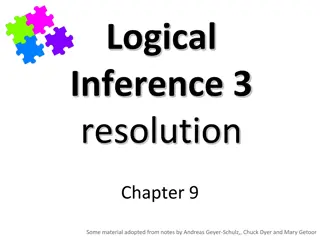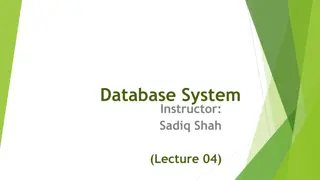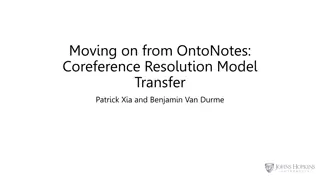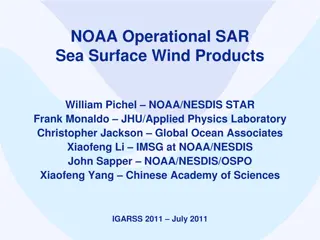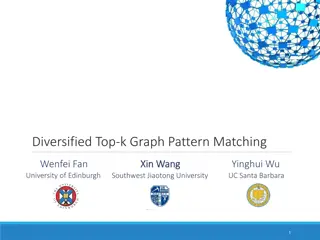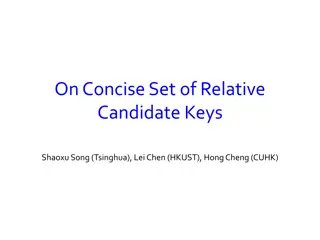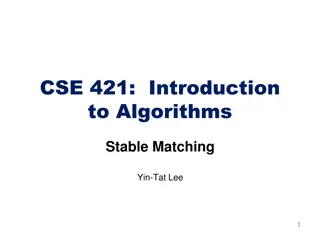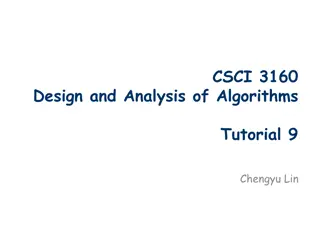Entity Resolution Problem in Customer Data Matching
The challenge of entity resolution, especially in the context of matching customer data between companies, is addressed in this content. The scenario involves accurately identifying which records correspond to the same individuals despite potential variations or errors in the data. Strategies such as Locality-Sensitive Hashing (LSH) with hash functions for names, addresses, and phone numbers are proposed to efficiently match similar records. A scoring mechanism is designed to evaluate the similarity of records, accounting for misspellings and other discrepancies. Additionally, techniques for hashing strings and handling large volumes of data are explored to optimize the matching process. The importance of identifying reliable scoring values through data analysis is also highlighted.
Download Presentation

Please find below an Image/Link to download the presentation.
The content on the website is provided AS IS for your information and personal use only. It may not be sold, licensed, or shared on other websites without obtaining consent from the author.If you encounter any issues during the download, it is possible that the publisher has removed the file from their server.
You are allowed to download the files provided on this website for personal or commercial use, subject to the condition that they are used lawfully. All files are the property of their respective owners.
The content on the website is provided AS IS for your information and personal use only. It may not be sold, licensed, or shared on other websites without obtaining consent from the author.
E N D
Presentation Transcript
Jeffrey D. Ullman Stanford University
The entity-resolution problem is to examine a collection of records and determine which refer to the same entity. Entities could be people, events, etc. Typically, we want to merge records if their values in corresponding fields are similar. 3
I once took a consulting job solving the following problem: Company A agreed to solicit customers for Company B, for a fee. They then argued over how many customers. Neither recorded exactly which customers were involved. 4
Each company had about 1 million records describing customers that might have been sent from A to B. Records had name, address, and phone, but for various reasons, they could be different for the same person. E.g., misspellings, but there are many sources of error. 5
Problem: (1 million)2 is too many pairs of records to score. Solution: A simple LSH. Three hash functions: exact values of name, address, phone. Compare iff records are identical in at least one. Misses similar records with a small differences in all three fields. 6
Design a measure (score ) of how similar records are: E.g., deduct points for small misspellings ( Jeffrey vs. Jeffery ) or same phone with different area code. Score all pairs of records that the LSH scheme identified as candidates; report high scores as matches. 7
Problem: How do we hash strings such as names so there is one bucket for each string? Answer: Sort the strings instead. Another option was to use a few million buckets, and deal with buckets that contain several different strings. 8
We were able to tell what values of the scoring function were reliable in an interesting way. Identical records had an average creation-date difference of 10 days. We only looked for records created within 90 days of each other, so bogus matches had a 45- day average difference in creation dates. 9
By looking at the pool of matches with a fixed score, we could compute the average time- difference, say x, and deduce that fraction (45-x)/35 of them were valid matches. Alas, the lawyers didn t think the jury would understand. 10
Any field not used in the LSH could have been used to validate, provided corresponding values were closer for true matches than false. Example: if records had a height field, we would expect true matches to be close, false matches to have the average difference for random people. 11
The Political-Science Dept. at Stanford asked a team from CS to help them with the problem of identifying duplicate, on-line news articles. Problem: the same article, say from the Associated Press, appears on the Web site of many newspapers, but looks quite different. 13
Each newspaper surrounds the text of the article with: It s own logo and text. Ads. Perhaps links to other articles. A newspaper may also crop the article (delete parts). 14
The team came up with its own solution, that included shingling, but not minhashing or LSH. A special way of shingling that appears quite good for this application. LSH substitute: candidates are articles of similar length. 15
I told them the story of minhashing + LSH. They implemented it and found it faster for similarities below 80%. Aside: That s no surprise. When the similarity threshold is high, there are better methods see Sect. 3.9 of MMDS and/or YouTube videos 8-4, 8-5, and 8-6. 16
Their first attempt at minhashing was very inefficient. They were unaware of the importance of doing the minhashing row-by-row. Since their data was column-by-column, they needed to sort once before minhashing. 17
The team observed that news articles have a lot of stop words, while ads do not. Buy Sudzo vs. I recommend that you buy Sudzo for your laundry. They defined a shingle to be a stop word and the next two following words. 18
By requiring each shingle to have a stop word, they biased the mapping from documents to shingles so it picked more shingles from the article than from the ads. Pages with the same article, but different ads, have higher Jaccard similarity than those with the same ads, different articles. 19
Generalized LSH is based on some kind of distance between points. Similar points are close. Example: Jaccard similarity is not a distance; 1 minus Jaccard similarity is. 21
d is a distance measure if it is a function from pairs of points to real numbers such that: 1. d(x,y) > 0. 2. d(x,y) = 0 iff x = y. 3. d(x,y) = d(y,x). 4. d(x,y) < d(x,z) + d(z,y) (triangle inequality). 22
L2 norm: d(x,y) = square root of the sum of the squares of the differences between x and y in each dimension. The most common notion of distance. L1 norm: sum of the differences in each dimension. Manhattan distance = distance if you had to travel along coordinates only. 23
b = (9,8) L2-norm: dist(a,b) = (42+32) = 5 5 3 4 L1-norm: dist(a,b) = 4+3 = 7 a = (5,5) 24
People have defined Lr norms for any r, even fractional r. What do these norms look like as r gets larger? What if r approaches 0? 25
Jaccard distance for sets = 1 minus Jaccard similarity. Cosine distance for vectors = angle between the vectors. Edit distance for strings = number of inserts and deletes to change one string into another. 26
Consider x = {1,2,3,4} and y = {1,3,5} Size of intersection = 2; size of union = 5, Jaccard similarity (not distance) = 2/5. d(x,y) = 1 (Jaccard similarity) = 3/5. 27
d(x,y) > 0 because |xy| < |xy|. Thus, similarity < 1 and distance = 1 similarity > 0. d(x,x) = 0 because x x = x x. And if x y, then |x y| is strictly less than |x y|, so sim(x,y) < 1; thus d(x,y) > 0. d(x,y) = d(y,x) because union and intersection are symmetric. d(x,y) < d(x,z) + d(z,y) trickier next slide. 28
d(x,z) d(z,y) d(x,y) 1 - |x z| + 1 - |y z| > 1 -|x y| |x z| |y z| |x y| Remember: |a b|/|a b| = probability that minhash(a) = minhash(b). Thus, 1 - |a b|/|a b| = probability that minhash(a) minhash(b). Need to show: prob[minhash(x) minhash(y)] < prob[minhash(x) minhash(z)] + prob[minhash(z) minhash(y)] 29
Whenever minhash(x) minhash(y), at least one of minhash(x) minhash(z) and minhash(z) minhash(y) must be true. minhash(x) minhash(y minhash(z) minhash(y) minhash(x) minhash(z) 30
Think of a point as a vector from the origin [0,0, ,0] to its location. Two points vectors make an angle, whose cosine is the normalized dot-product of the vectors: p1.p2/|p2||p1|. Example: p1 = [1,0,2,-2,0]; p2 = [0,0,3,0,0]. p1.p2 = 6; |p1| = |p2| = 9 = 3. cos( ) = 6/9; is about 48 degrees. 31
The edit distance of two strings is the number of inserts and deletes of characters needed to turn one into the other. An equivalent definition: d(x,y) = |x| + |y| - 2|LCS(x,y)|. LCS = longest common subsequence = any longest string obtained both by deleting from x and deleting from y. 32
x = abcde ; y = bcduve. Turn x into y by deleting a, then inserting u and v after d. Edit distance = 3. Or, computing edit distance through the LCS, note that LCS(x,y) = bcde. Then:|x| + |y| - 2|LCS(x,y)| = 5 + 6 2*4 = 3 = edit distance. Question for thought: An example of two strings with two different LCS s? Hint: let one string be ab. 33
There is a subtlety about what a hash function is, in the context of LSH families. A hash function h really takes two elements x and y, and returns a decision whether x and y are candidates for comparison. Example: the family of minhash functions computes minhash values and says yes iff they are the same. Shorthand: h(x) = h(y) means h says yes for pair of elements x and y. 35
Suppose we have a space S of points with a distance measure d. A family H of hash functions is said to be (d1,d2,p1,p2)-sensitive if for any x and y in S: 1. If d(x,y) < d1, then the probability over all h in H, that h(x) = h(y) is at least p1. 2. If d(x,y) > d2, then the probability over all h in H, that h(x) = h(y) is at most p2. 36
p1 High probability; at least p1 Low probability; at most p2 ??? p2 d2 d1 37
Let: S = subsets of some universal set, d = Jaccard distance, H formed from the minhash functions for all permutations of the universal set. Then Prob[h(x)=h(y)] = 1-d(x,y). Restates theorem about Jaccard similarity and minhashing in terms of Jaccard distance. 38
Claim: H is a (1/3, 3/4, 2/3, 1/4)-sensitive family for S and d. Then probability that minhash values agree is < 1/4 If distance > 3/4 (so similarity < 1/4) Then probability that minhash values agree is > 2/3 If distance < 1/3 (so similarity > 2/3) For Jaccard similarity, minhashing gives us a (d1,d2,(1-d1),(1-d2))-sensitive family for any d1 < d2. 39
The bands technique we learned for signature matrices carries over to this more general setting. Goal: the S-curve effect seen there. AND construction like rows in a band. OR construction like many bands. 40
Given family H, construct family H whose members each consist of r functions from H. For h = {h1, ,hr} in H , h(x)=h(y) if and only if hi(x)=hi(y) for all i. Theorem: If H is (d1,d2,p1,p2)-sensitive, then H is (d1,d2,(p1)r,(p2)r)-sensitive. Proof: Use fact that hi s are independent. Also lowers probability for small distances (Bad) Lowers probability for large distances (Good) 41
Given family H, construct family H whose members each consist of b functions from H. For h = {h1, ,hb} in H , h(x)=h(y) if and only if hi(x)=hi(y) for some i. Theorem: If H is (d1,d2,p1,p2)-sensitive, then H is (d1,d2,1-(1-p1)b,1-(1-p2)b)-sensitive. Raises probability for small distances (Good) Raises probability for large distances (Bad) 42
By choosing b and r correctly, we can make the lower probability approach 0 while the higher approaches 1. As for the signature matrix, we can use the AND construction followed by the OR construction. Or vice-versa. Or any sequence of AND s and OR s alternating. 43
Each of the two probabilities p is transformed into 1-(1-pr)b. The S-curve studied before. Example: Take H and construct H by the AND construction with r = 4. Then, from H , construct H by the OR construction with b = 4. 44
p .2 .3 .4 .5 .6 .7 .8 .9 1-(1-p4)4 .0064 .0320 .0985 .2275 .4260 .6666 .8785 .9860 Example: Transforms a (.2,.8,.8,.2)-sensitive family into a (.2,.8,.8785,.0064)- sensitive family. 45
Each of the two probabilities p is transformed into (1-(1-p)b)r. The same S-curve, mirrored horizontally and vertically. Example: Take H and construct H by the OR construction with b = 4. Then, from H , construct H by the AND construction with r = 4. 46
p .1 .2 .3 .4 .5 .6 .7 .8 (1-(1-p)4)4 .0140 .1215 .3334 .5740 .7725 .9015 .9680 .9936 Example: Transforms a (.2,.8,.8,.2)-sensitive family into a (.2,.8,.9936,.1215)- sensitive family. 47
Example: Apply the (4,4) OR-AND construction followed by the (4,4) AND-OR construction. Transforms a (.2,.8,.8,.2)-sensitive family into a (.2,.8,.9999996,.0008715)-sensitive family. 48
For each AND-OR S-curve 1-(1-pr)b, there is a thresholdt, for which 1-(1-tr)b = t. Above t, high probabilities are increased; below t, low probabilities are decreased. You improve the sensitivity as long as the low probability is less than t, and the high probability is greater than t. Iterate as you like. Similar observation for the OR-AND type of S- curve: (1-(1-p)b)r. 49
Probability Is raised Threshold t Probability Is lowered p t 50
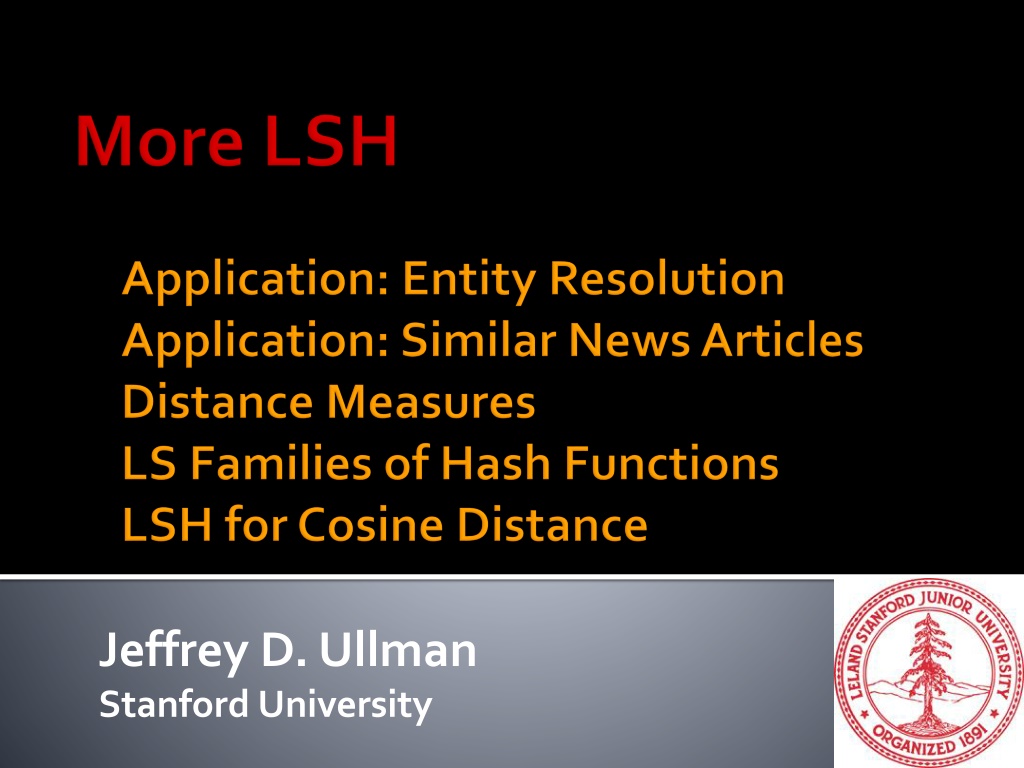
 undefined
undefined






